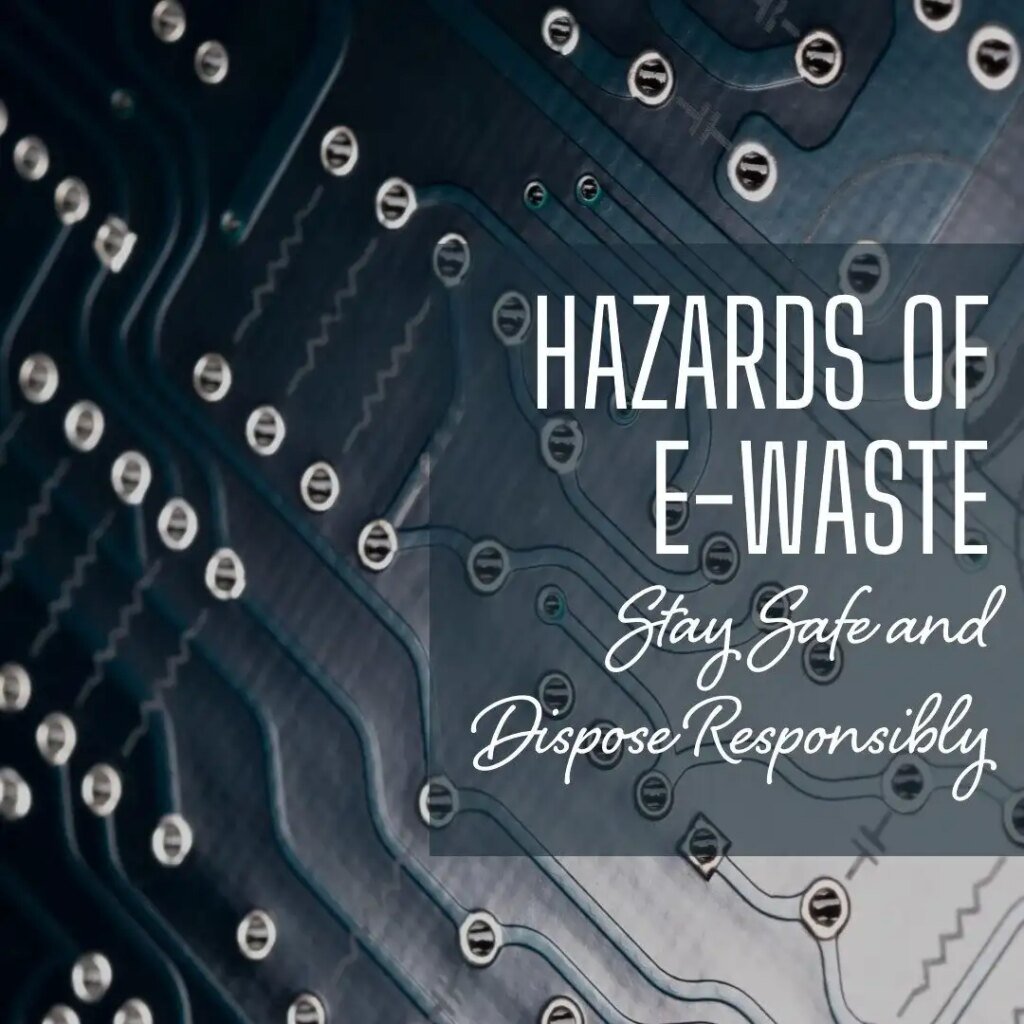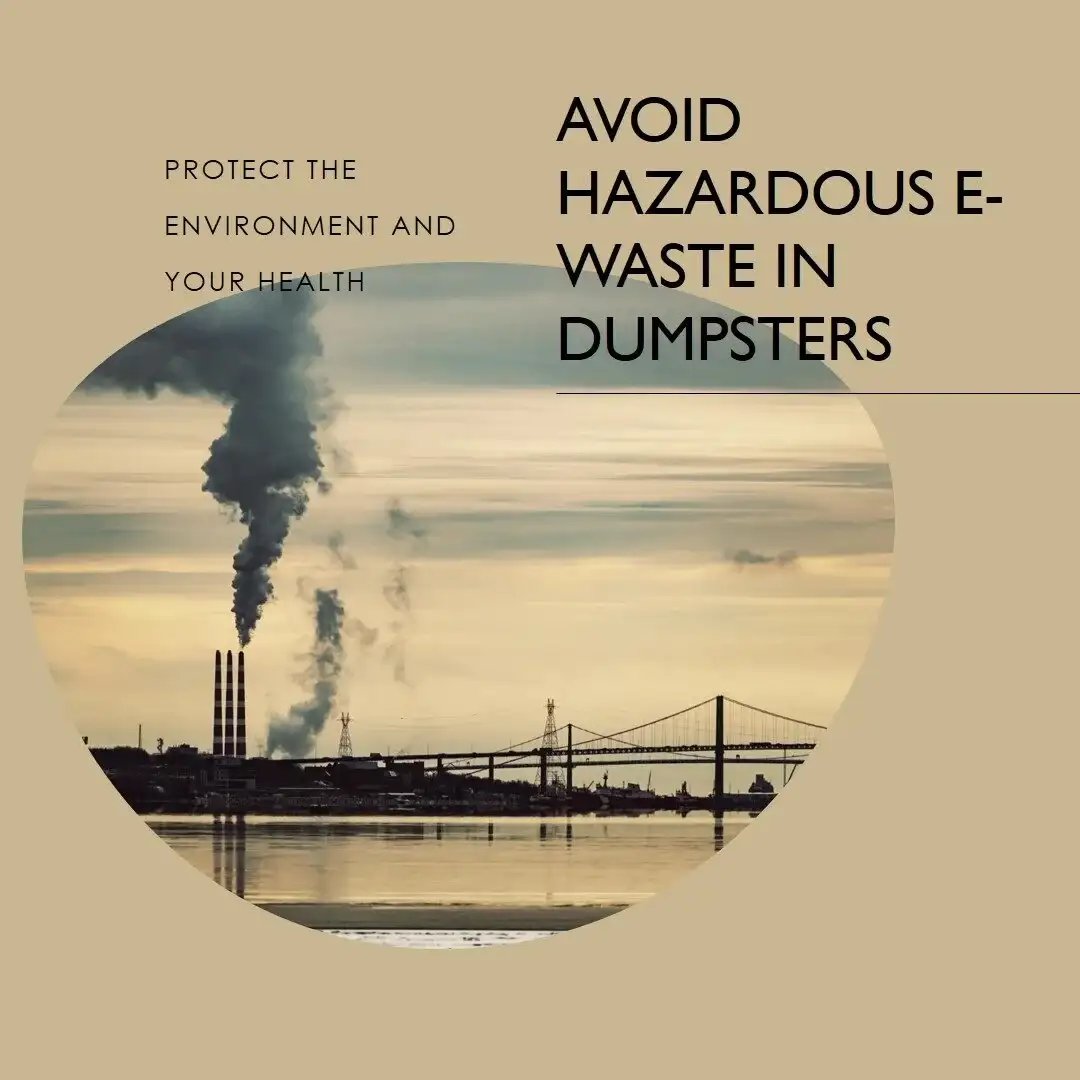E-waste, short for electronic waste, refers to any discarded electronic devices or equipment that have reached the end of their useful life. This includes computers, laptops, mobile phones, televisions, and other electronic appliances. E-waste contains hazardous materials such as lead, mercury, cadmium, and brominated flame retardants, which can have detrimental effects on human health and the environment when improperly disposed of.
The Importance of Proper E-Waste Disposal
Proper e-waste disposal is crucial for several reasons:
- Environmental Protection: E-waste contains toxic substances that can contaminate the soil, water, and air if not handled correctly. By disposing of e-waste through appropriate channels, we can minimize the environmental impact and prevent these hazardous materials from leaching into the ecosystem.
- Resource Conservation: Many electronic devices contain valuable materials such as gold, silver, and copper. Recycling e-waste allows for the extraction of these precious resources, reducing the need for mining and conserving natural reserves.
- Data Security: Improper disposal of electronic devices can pose a significant risk of data breaches. A proper e-waste disposal process ensures that personal and sensitive information stored on these devices is safely and securely destroyed.
- Compliance with Regulations: Many countries have strict regulations in place for e-waste management. Proper disposal helps individuals and businesses comply with these regulations and avoid potential legal and financial consequences.
In conclusion, proper disposal of e-waste is essential for protecting the environment, conserving resources, ensuring data security, and complying with regulations. Proper disposal channels, such as certified e-waste recycling centers, should be utilized to minimize the negative impacts associated with e-waste disposal.
Dangers of Improper Disposal of Hazardous E-Waste
Improper disposal of hazardous e-waste can have severe consequences:
- Environmental contamination: When e-waste is not properly handled, hazardous materials can leach into the soil, water, and air, posing a threat to ecosystems, plants, and animals.
- Health risks: Exposure to hazardous substances in e-waste can lead to respiratory problems, neurological disorders, organ damage, and even cancer.
- Fire hazards: Certain e-waste components, such as lithium-ion batteries, pose a fire risk if not disposed of correctly.
- Illegal recycling operations: Improperly discarded e-waste becomes attractive to illegal recycling operators, leading to unsafe practices that further harm the environment.
To mitigate these dangers, it is crucial to dispose of hazardous e-waste through proper channels and support certified e-waste recycling centers that can safely handle and dispose of these materials.

How to Identify Hazardous E-Waste
Electronic devices of all types can contain hazardous materials. Some common examples include:
- Computers and laptops: These devices often have circuit boards and batteries that may contain lead, mercury, and other toxic substances.
- Televisions and monitors: Older models may contain cathode ray tubes (CRTs), which contain lead and other hazardous materials.
- Mobile phones and tablets: These devices may contain batteries that could contain metals like lithium or cadmium.
- Printers and scanners: Certain components, such as ink cartridges and toner, may have hazardous chemicals.
Signs of Potential Hazardous Materials in E-Waste
It may not always be obvious that a piece of electronic waste contains hazardous materials. However, there are some signs that can indicate potential risks, including:
- Labels or markings that indicate the presence of hazardous substances.
- The device is heavy or bulky, indicating the use of lead in batteries or circuit boards.
- The device has parts that are discolored or corroded, which could suggest the presence of harmful chemicals.
- The manufacturer’s documentation warns about handling or disposal procedures due to the presence of hazardous materials.
To ensure the safe handling of e-waste, it is best to rely on certified recycling centers or collection programs that can properly identify and dispose of hazardous materials found in electronic devices.
Proper Disposal Methods
Proper disposal of e-waste involves recycling the devices safely and responsibly. This can be done through specialized recycling facilities that have the knowledge and equipment to handle hazardous materials. This process typically involves:
- Disassembling the electronic devices to separate the different components, such as plastics, metals, and circuit boards.
- Recovering valuable materials, like precious metals and rare earth elements, for reuse or recycling.
- Properly disposing of hazardous materials following local regulations and guidelines.
Certified E-Waste Collection Centers
One of the best ways to ensure proper disposal of e-waste is to utilize certified e-waste collection centers. These centers have the necessary expertise to identify hazardous materials and handle them safely. Advantages of using certified e-waste collection centers include:
- Proper management and disposal of hazardous components, reducing the risk of environmental contamination.
- Compliance with local regulations and laws regarding the disposal of e-waste.
- Assurances that the collected e-waste will be recycled or disposed of in an environmentally responsible manner.
By utilizing certified e-waste collection centers and following proper disposal methods, individuals and organizations can contribute to the protection of the environment and the reduction of hazardous materials in e-waste.
Risks of Dumping E-Waste in Dumpsters
Dumping electronic waste (e-waste) in dumpsters diving can have severe environmental consequences. Here are some of the key risks:
- Contamination of Soil and Water: E-waste contains hazardous materials such as lead, mercury, and cadmium. When these devices end up in landfills, these toxic substances can seep into the soil and water, polluting the surrounding environment.
- Air Pollution: Some e-waste components, like circuit boards and batteries, release harmful chemicals when they break down. Dumping them in landfills can lead to the release of these pollutants into the air, contributing to air pollution and potentially harming human health.
- Resource Depletion: Many electronic devices contain valuable materials like copper, gold, and rare earth elements. By dumping e-waste instead of recycling it, these valuable resources are lost and need to be newly mined, causing additional environmental impact.
Health Risks Associated with Improper E-Waste Disposal
Improper disposal of e-waste can also pose serious health risks, including:
- Exposure to Toxic Substances: People who come into contact with dumped e-waste may be exposed to hazardous materials like lead, mercury, and arsenic. These substances can have detrimental health effects, such as neurological damage, respiratory issues, and organ damage.
- Contamination of Food and Water: When hazardous substances from e-waste leach into the environment, they can contaminate food sources and drinking water. Consuming such contaminated food and water can lead to serious health problems.
- Occupational Hazards: Dumping e-waste in dumpsters also puts waste management workers at risk. These workers might unknowingly handle devices with hazardous materials, potentially harming their health if proper safety measures are not taken.
It is crucial to promote proper e-waste disposal methods to minimize these risks and protect the environment and human health. Utilizing certified e-waste collection centers or recycling facilities ensures that e-waste is handled safely, minimizing its impact on the environment and human well-being.
Legal Regulations and Compliance
Dumping e-waste in dumpsters is not only harmful to the environment and human health, but it is also illegal in many jurisdictions. Governments around the world have implemented regulations to address the growing problem of e-waste disposal. These regulations aim to promote responsible disposal practices and ensure the proper management of electronic waste.
Some common elements of e-waste regulations include:
- Mandatory Recycling: Many jurisdictions require the recycling of electronic waste. This means that individuals and businesses are obligated to dispose of their e-waste through certified recycling facilities rather than dumping it in regular dumpsters.
- Extended Producer Responsibility (EPR): E-waste regulations often include EPR programs, which hold manufacturers responsible for the proper disposal and recycling of their electronic products. This encourages manufacturers to design products that are more environmentally friendly and easier to recycle.
- Reporting and Documentation: Some regulations require businesses to keep records of their e-waste management activities and submit periodic reports to demonstrate compliance with the law.
Penalties for Illegal E-Waste Disposal
Illegal e-waste disposal can result in significant penalties and fines. The specific penalties vary depending on the jurisdiction, but they can include:
- Fines: Individuals or businesses found guilty of illegal e-waste disposal may face substantial fines. These fines serve as a deterrent and help fund programs that promote proper e-waste management.
- Criminal Charges: In some cases, illegal e-waste disposal can lead to criminal charges. This can result in imprisonment or other severe legal consequences.
- License Revocation: Businesses engaged in illegal e-waste disposal may have their licenses revoked. This can have severe implications for their operations and reputation.
It is essential for individuals and businesses to stay informed about the e-waste regulations in their region and comply with them to avoid legal repercussions. By adhering to these regulations, we can protect the environment, safeguard human health, and promote a more sustainable approach to e-waste management.

What are some common hazardous materials found in e-waste?
Electronic waste, or e-waste, often contains a variety of hazardous materials that can pose significant risks to human health and the environment if not properly managed. Some common hazardous materials found in e-waste include:
- Lead: Lead is commonly found in the solder used to join electronic components. It can cause damage to the nervous system, kidneys, and reproductive system, particularly in children and pregnant women.
- Mercury: Mercury is often present in older devices such as fluorescent lamps, switches, and thermostats. It can cause severe neurological damage and harm to the kidneys and reproductive system.
- Cadmium: Cadmium is used in rechargeable batteries found in many electronic devices. Exposure to cadmium can lead to lung and prostate cancer, as well as kidney damage.
- Brominated flame retardants (BFRs): BFRs are used in the plastic casings of electronic devices to reduce flammability. They can leach out of the plastic over time and accumulate in the environment, posing risks to human health and wildlife.
- Polyvinyl Chloride (PVC): PVC is commonly used in cables and wires. When burned, it releases dioxins and furans, which are highly toxic compounds that can cause cancer and reproductive disorders.
- Chlorofluorocarbons (CFCs): CFCs are used in older refrigerators and air conditioners as cooling agents. They are potent greenhouse gases that also deplete the ozone layer, contributing to climate change and harming the environment.
- Arsenic: Arsenic is used in the manufacture of certain electronic components, such as semiconductors. Exposure to arsenic can cause skin lesions, and respiratory issues, and increase the risk of cancer.
- Polybrominated Biphenyls (PBBs): PBBs are similar to BFRs and were historically used as flame retardants in electronic devices. They are persistent organic pollutants that can bioaccumulate in the food chain, posing risks to human health and the environment.
Proper handling and recycling of e-waste are essential to prevent these hazardous materials from contaminating the environment and endangering public health. Recycling processes should be conducted by certified facilities that adhere to strict environmental and safety standards to minimize the risks associated with e-waste disposal.
Tips for Safe E-Waste Disposal
When it comes to handling and transporting e-waste, it’s important to follow best practices to ensure safe and responsible disposal. Here are some tips to keep in mind:
- Store e-waste in a secure and dry area to prevent any potential damage or leakage of hazardous materials.
- Use appropriate packaging materials, such as sturdy boxes or containers, to protect the e-waste during transportation.
- If possible, remove any personal data from electronic devices before disposing of them to protect your privacy.
- Follow any specific instructions provided by the recycling facility, such as removing batteries or separating different types of e-waste.
Resources for Finding Authorized E-Waste Recyclers
Finding authorized e-waste recyclers is crucial to ensure that your electronic waste is handled properly and in compliance with regulations. Here are some resources you can use to find authorized e-waste recyclers in your area:
- Check with your local government or environmental agency for a list of authorized e-waste recycling facilities.
- Look for certifications, such as e-stewards or R2, which indicate that a recycling facility meets specific standards for responsible e-waste management.
- Use online directories or search engines dedicated to finding e-waste recyclers, such as the Electronics Recycling Locator provided by the Environmental Protection Agency (EPA).
Remember, by following best practices for handling and transporting e-waste, as well as utilizing authorized recyclers, you can contribute to the proper management of electronic waste and help protect the environment and human health.

Raising Awareness and Promoting Sustainability
When it comes to e-waste reduction, individuals have an important role to play in minimizing the environmental impact of electronic waste. Here are some ways individuals can contribute:
- Proper Disposal: Individuals should follow best practices for handling and transporting e-waste, ensuring it is stored securely and transported in appropriate packaging.
- Data Protection: Take steps to remove personal data from electronic devices before disposing of them to protect privacy.
- Reuse and Recycle: Consider alternatives to disposal by reusing or donating still-functional devices. When recycling, make sure to use authorized e-waste recyclers.
- Education and Awareness: Spread knowledge about e-waste management within your community, encouraging others to adopt responsible practices.
Encouraging Sustainable Electronic Consumption
To promote sustainability in electronic consumption, both individuals and society as a whole can take several actions:
- Product Lifespan: Choose electronic devices that are designed for durability and longevity. Avoid purchasing products known for their short lifespan or lack of repairability.
- Repair and Upgrades: Opt for repair and upgrades instead of automatically replacing electronic devices. This extends their useful life and reduces the need for new purchases.
- Eco-friendly Options: Consider purchasing electronic devices that are made from recycled materials or have eco-friendly certifications.
- Responsible Disposal: Dispose of electronic devices responsibly, following proper e-waste management practices to ensure they are recycled or disposed of safely.
By raising awareness about the importance of e-waste reduction and promoting sustainable electronic consumption, we can all contribute to a healthier environment and a more sustainable future.
Conclusion
Responsible e-waste disposal is essential to minimize the negative impact on the environment. By following best practices for handling, transporting, and storing e-waste, individuals can contribute to reducing its harmful effects.
Encouraging a Greener Future
By raising awareness about the importance of e-waste reduction and promoting sustainable electronic consumption, we can all contribute to a healthier environment and a more sustainable future. Taking steps such as choosing durable devices, opting for repair and upgrades, and practicing responsible disposal can make a significant difference in minimizing electronic waste and promoting a greener world.

Greetings, eco-conscious explorers! I am Arjun Bandari, a seasoned Dumpster Diving enthusiast with over a decade of expertise in uncovering hidden treasures amidst the discarded. My journey into this unconventional lifestyle began in New York, fueled by a passion for sustainability and a desire to challenge the norms of our throwaway culture.
With a bachelor’s in Enviromental Health and Safety, I seamlessly blend academic insights with practical experiences to navigate the world of Dumpster Diving. Over the years, I’ve become a recognized figure in the sustainable living community, sharing my discoveries and insights through workshops, community outreach, and various online platforms.
My commitment to promoting eco-friendly practices has garnered attention from local and regional media, earning me featured spots in publications that highlight the environmental impact of Dumpster Diving. As an advocate for responsible waste management, I have been honored with awards recognizing my contributions to the field.
In addition to my hands-on experiences, I’ve extended my reach through various published works, shedding light on the untapped potential within discarded items. Whether it’s repurposing furniture, salvaging electronics, or sharing practical tips for fellow Dumpster Diving enthusiasts, I am dedicated to inspiring a conscious and sustainable way of living.
Join me on this exciting journey as we redefine the narrative around waste, discover hidden gems, and collectively contribute to a greener, more sustainable future. Together, let’s dive into the world of Dumpster Diving and uncover the beauty beneath the surface of our disposable society.

